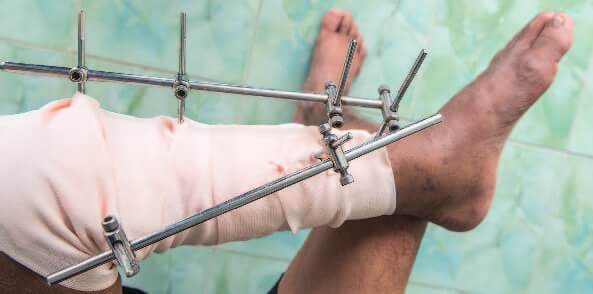
A compression break on a tibia can be a painful experience from which it is difficult to heal. Such a severe injury can cause extreme pain for a significant period of time, and patients often need consistent care – care which is near impossible to find while migrating. Ramona*, a woman in her early 30s from Central America, was enrolled in Health Network by a shelter on the US-Mexico border for a painful tibia fracture, which she sustained while crossing the US-Mexico border in search of asylum. At the time of enrollment, Ramona had already sought care at the border. Her initial treatment was provided by a team of orthopedic surgeons in Texas, who fitted her with an external fixator. The fixator is a brace that is applied externally to keep the fractured bone stabilized and in alignment. She was on her way to family in the mid-Atlantic region, so her clinician enrolled her in Health Network, Migrant Clinicians Network’s virtual case management program, to connect her with care on the East Coast.
Nestor Reyes, Health Network Associate, was assigned her case. Reyes began by working to find her a primary care provider, after which he would find her the specialty care she needed for her tibia. This would entail numerous calls to community health centers near her new home, trying to find a center that would accept her despite her low income and immigration status, and gathering and transferring medical records from the border. Ramona’s care had several complicating factors. Such fractures are difficult to heal and take significant time, and patients often need to take medication like anti-coagulants or antibiotics to prevent pinpoint infections. Consistent care is important with cases like Ramona’s. However, complications around transfer of care and records created an especially challenging situation for Ramona, including struggles to get her past medical records in order to forward them, and related challenges for Ramona’s clinicians to pick up her care where her previous clinicians left off.
She was seen at a hospital near her family, complaining of pain from her external fixator. At this point, Ramona’s fixator had been in place for four months. This is typically on the lower end of what an orthopedic specialist may consider enough time with a fixator before the device can be removed and the healing can be completed with a standard cast. Because of this, there was some question of whether it should be removed yet, or if there was anything that could be done to reduce the pain from the contraption. It would not be unusual for a doctor to decide that the fixator needed to remain for another four months, but usually patients work with the same team or trusted colleagues from the time the fixator is applied to when it is removed. Ramona’s interrupted care because of migration is far from common.
Ramona’s clinicians on the East Coast felt unprepared to remove her external fixator, and the team of physicians that handled her initial case had to meet to discuss the possibility of removing it and the time frame in which that needed to occur. The case was not just frustrating for Ramona, but for Reyes and the doctors as well. After a lengthy period of debate and communication between her, Reyes, and the various doctors she had seen, she decided on her own to return to Texas to have the original team remove the fixator.
For her, this meant a harrowing journey of well over 20 hours on the road, all while dealing with the severe pain she initially complained to her mid-Atlantic medical team about. She was finally able to have the fixator removed in the border state where she entered the US, so she could continue her healing in a more traditional cast.
After Ramona returned to the East Coast with the fixator removed, Reyes stepped in once more to assist her in scheduling follow-up appointments and connecting Ramona to needed physical therapy. With no income and little support, Ramona continues to struggle to get to her follow-up appointments. Reyes has contacted many health centers and clinics to find assistance, but transportation is still a primary issue. As with many Health Network patients, overlapping barriers to care result in many hours of work for Health Network Associates, and, sometimes, the support they need is unavailable locally. Reyes will continue to support Ramona as best as he can until she completes treatment for her tibia break, or until Ramona confirms she no longer needs assistance.
*Name and geographic details are changed or anonymized for the protection of the patient’s identity.